The Neolithic people managed to populate the whole of the Iberian peninsula within 1000 years and then they met the Mesolithic people living on the Atlantic coast.
By Nick Nutter | Updated 24 Aug 2022 | Andalucia | History |
Login to add to YOUR Favourites or Read Later
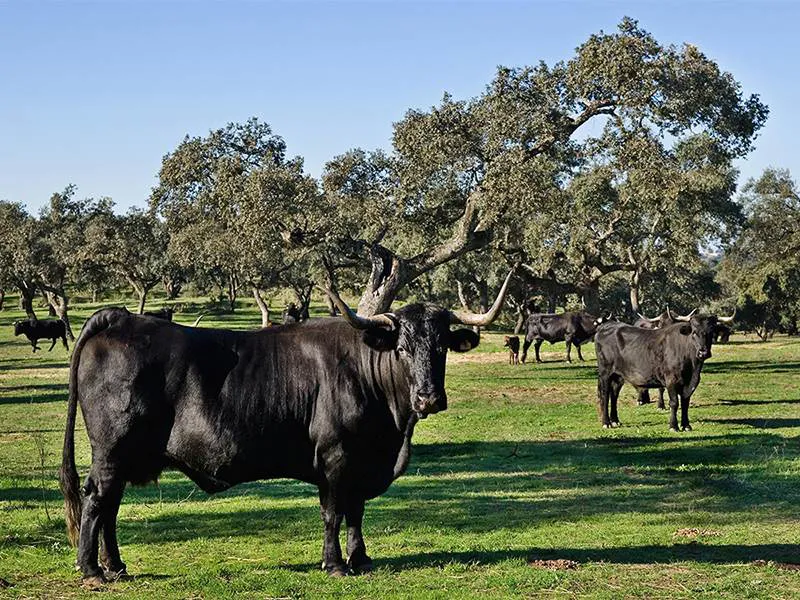
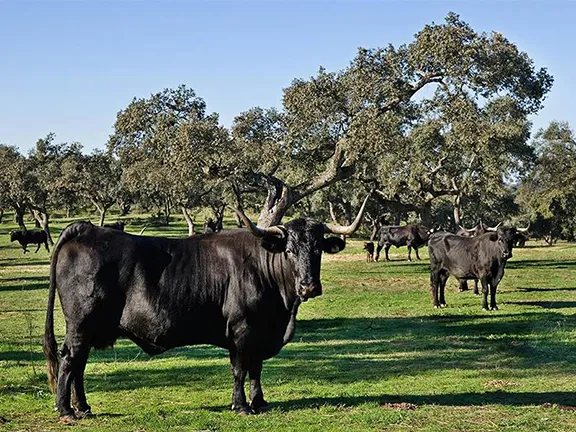
Negra Andaluza
At the close of ‘The Mesolithic in Andalucia’ we looked at how climate change after 5800 BC forced the Mesolithic communities to abandon most of their established sites and concentrate in the areas that offered a sustainable supply of food throughout the year, principally the Muge shell midden sites of the Tagus estuary and sites on the Sado estuary, both in Portugal, leaving Andalucia, according to the archaeological evidence, essentially, abandoned.
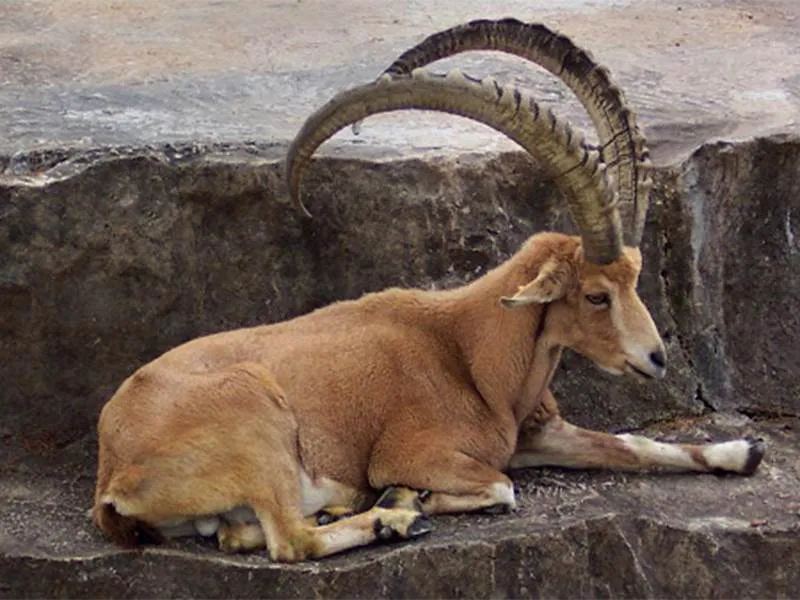
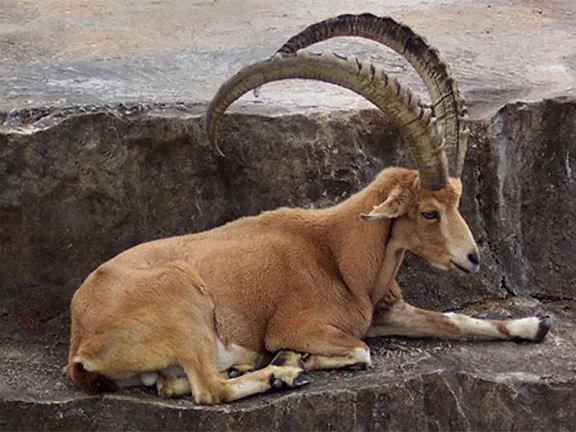
Capra ibex
A similar occurrence may have taken place south of the Alps. In ‘The Neolithic Expansion to Andalucia’, we mentioned the temporary cessation of Neolithic advance in an area south of the Alps from about 6000 BC to 5400 BC and hypothesised that this was due to the continued presence of Mesolithic people. It could be that the cold, arid conditions that started in the west about 5800 BC and reached the eastern Mediterranean about 4500 BC, forced the Mesolithic bands south of the Alps to abandon their territories about 5400 BC, leaving the area open for a continuation of the Neolithic advance.
In ‘The Neolithic Expansion to Andalucia’ we looked at how the Neolithic people had moved from their homeland in the Fertile Crescent, west through the Mediterranean regions by land and sea until they arrived in Andalucia about 5800 BC, in the middle of a climate change that had lowered temperatures by 30C and created arid conditions in much of Andalucia.
It has been observed that, in general, the Neolithic settlement pattern in the Iberian Peninsula, was to establish a semi-permanent base on the coast, increase the population for a generation or two and then move further along the coast and inland via the river valleys. In the early parts of the Neolithic, cave sites were preferred to open sites.
Having established themselves in Catalonia and Valencia, the Neolithic people avoided the arid zone in Almeria entirely. In Andalucia, the earliest signs of Neolithic activity appear at locations with a constant supply of fresh water. Bajondilla, Hostal Guadalupe and Roca Chica were near the Guadalhorce river and fresh water springs at Torremolinos, the Totalán river and springs of La Araña supplied Complejo del Humo and the Spring of Maro is close to Nerja Cave, all in Malaga province.
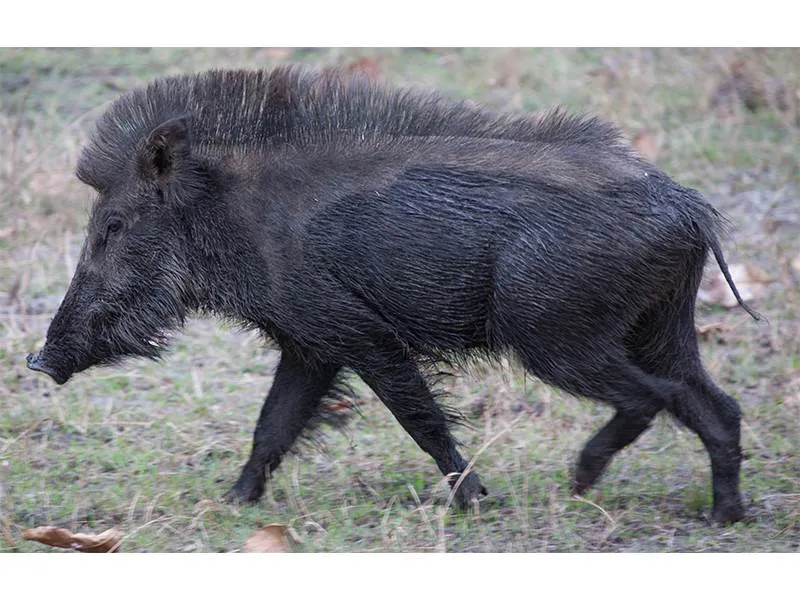
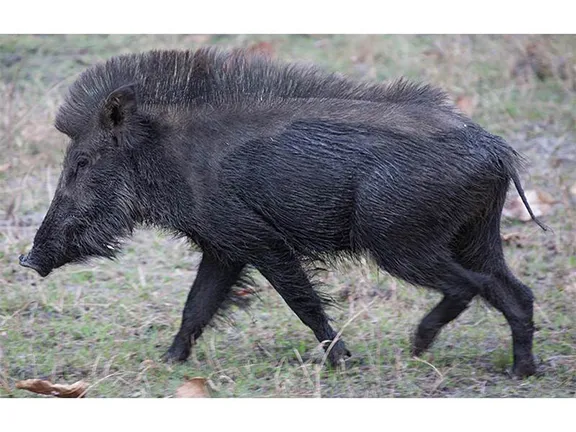
Sus scrofa
Some researchers have suggested that the colonisation of Andalucia, west of Almeria at least, took place from North Africa. They cite the following reasons:
a) Ceramics discovered at sites in Andalucia are similar in form and decoration to those found in Neolithic sites in the Oran region and the eastern Rif.
b) In Portugal, Andalucia and North Africa, the stone tool kit is slightly different to that found in Valencia. The technical difference is the presence of segments and absence of Valencian trapezes in the stone tools. There is evidence of the heat treatment of flint in the Early Neolithic levels from sites in Portugal, Andalucia, and North Africa, whereas in the Iberian Peninsula north of Almeria there is no evidence for this technique.
c) The presence of arrow or spear straighteners made of human bone in both the early Neolithic from Nerja and in other sites in Andalucia and the Maghreb (Algeria, Libya and Tunisia).
d) The unique features of sickles in the Malaga sites (i.e., flint implements inserted in a slightly diagonal position in the handle during the Early Neolithic. This pattern contrasts with the style found in Northern Iberia, where whole flint blades are inserted parallel to the handle.
e) Preliminary paleogenetic data from an individual from the Middle Neolithic levels of Nerja evidence a close genetic relationship with individuals of haplogroup L1b, commonly found in the West African tribes of Fulbe, Mandenka, and Yoruba and, less frequently, in Central and North Africa. The presence of an African mitochondrial haplogroup at Nerja does not necessarily indicate a recent African origin for that individual. It may be consistent with the fact that African ancestry was present in the region during earlier periods but obviously more data will be required to confirm a Neolithic African ancestry through genetic tracers.
The slight differences between the toolkits of the Neolithic people north of the non-populated arid area in Almeria, and that of those south of Almeria could equally be attributed to the separate development of those tools in two areas that found themselves temporarily isolated from one another. The Maghreb could just as easily have been populated from Andalucia as vice versa or it could have been populated in parallel and contemporaneously with Andalucia.
Early researchers found that, in the semi-permanent cave settlements, there was little difference between the previous Mesolithic layers and the later Neolithic layers. The later levels still showed a preponderance of wild cereals, fruits and nuts. In coastal areas, marine resources were still important. Only a few bones of domesticated animals were found, together with the bones of wild animals. They concluded that the occupants of the sites were Mesolithic people that had adopted some of the habits of the Neolithic, primarily, domesticating animals.
However, more recent research reveals that the Neolithization of Andalucia was a much more involved, more fluid and more dynamic process than heretofore recognised. The Mesolithic people remaining in some areas were key to the success of the Neolithic project. Indeed, it drew heavily on their knowledge of indigenous plants and animals and the geography of Andalucia, in what was an unexplored and unknown land for the newcomers. Mesolithic knowledge accumulated over thousands of years by many generations was complimented by the knowledge brought in by the Neolithic people. It should also not be forgotten that experiments involving plant seeds and to some extent animals, introduced into a new environment, with not quite the same temperature, humidity and seasonal variation as they are used to, despite being on a similar line of latitude, often fail, even in modern times. The early Neolithic settlers on Cyprus discovered that some two and a half thousand years before any Neolithic set foot in Andalucia.
Another factor largely ignored is the seafaring ability of the Neolithic people and the capability of boats to move cargo and people. We have already mentioned the growing trading/exchange networks on land and at sea. There is no reason to not imagine that the coastal sea and land routes saw increasing traffic in both directions, west and east. The first Neolithic experiments in Andalucia would have incurred some failures, just as they had on Cyprus, what better way to resupply than by sea, just as their Cypriot ancestors had done.
With a mental vision of fluidity and dynamism, we shall now look at how the Neolithic developed in Andalucia. Not on a site by site basis, rather as a progression of events, starting with the initial occupation and use of the landscape.
Before we embark on that task it is important to understand that the only archaeological sites dating from this period, and for that matter, from the late Mesolithic period, are situated on limestone. Open air sites, even semi-permanent settlements that may have existed in the sedimentary regions, for instance the Rio Guadalquivir valley, are invisible to us because they are beneath layers of sediment unless they are found by accident during agricultural or building works.
Early research into the first Neolithic communities in Andalucia concentrated on cave sites and much later research results and ideas of how the Neolithic progressed were biased because of this. Occasional reports emerged in the early 20th century about Neolithic activity at open air sites such as the coastal settlement at Almizaraque (Cuevas de Almanzora, Almeria) related to cave sites further inland. During the latter half of the 20th century, some outstanding work was done at other open air sites, at La Molaina (Pinos Puente, Granada), Catorce Fanegas (Cogollos Vega, Granada), La Dehesa (Lucena del Puerto, Huelva) and El Judío (Almonte, Huelva). Later work also focussed on the coastal sites of Almeria and the Bay of Cadiz areas. Areas that have very different dynamics, Cadiz on the relatively well watered Atlantic coast and arid Almeria, and different relationships with sites further inland. Gradually a picture emerged of how Neolithic people used the land.
Along the Atlantic belt, an area where the Mesolithic people were still in situ, the early Neolithic period saw no discontinuity in the use of stone and bone tools, nor in the strategies used in hunting, fishing and collecting shellfish and plants. Coastal settlements at El Retamar and La Dehesa were semi sedentary camps linked to sites inland. Pollen studies in the area show that there was no indication of agricultural activities until around 5000 BC.
In Almeria there is an absence of any Mesolithic records in the coastal area. Neolithic occupation and exploitation of resources was diversified. The occupancy pattern was a coexistence of two types of site, small hills or ridges adjacent to rivers, estuaries or bays, such as Cabecicos Negros where activities included the manufacture of sea shell personal ornamentation. The second type was situated on separate ridges with visual dominance over the landscape. The sites were visited repeatedly and occupied on a semi-permanent basis.
The next few paragraphs contain references to two caves, Los Murciélagos in inland Cordoba and Los Murciélagos, a coastal site in Granada province. The two are often confused so at every mention they will be defined by the province.
Evidence from inland sites indicates that interrelated sites, both caves and open air, show a territorial organisation pattern of seasonal occupation shaped according to the exploitation of diverse resources, agricultural, stone or mineral, or it has been proposed, control of droving routes. In the case of Los Murciélagos (Zuheros, Cordoba province) and Los Castillejos (Granada province), they would exercise control over the exploitation of the landscape based on pastoral activity, leading to stable or permanent occupation.
Cave sites had a number of functions. At Nerja cave (Malaga province), El Toro (Malaga province) and Castillo de Doña Mencía (Cordoba province) amongst others, human remains were mixed with animal remains and burnt, indicating a funerary practice, possibly a temporary deposit that would lead to a secondary burial. At La Dehesilla and El Toro, actual burials are associated with domestic living areas. Burials are also associated with some open air sites such as Cerro Virtud and El Retamar. El Toro was used for other purpose as well, food processing and consumption and craft activities and may also have been used as a sheep or goat pen. The cave at Ardales (Malaga province), was similarly used for multi-functional purposes. Los Murciélagos (Granada province) was similarly used, with the addition of the consumption of opium poppy, a practice linked by some researchers in a ritual context.
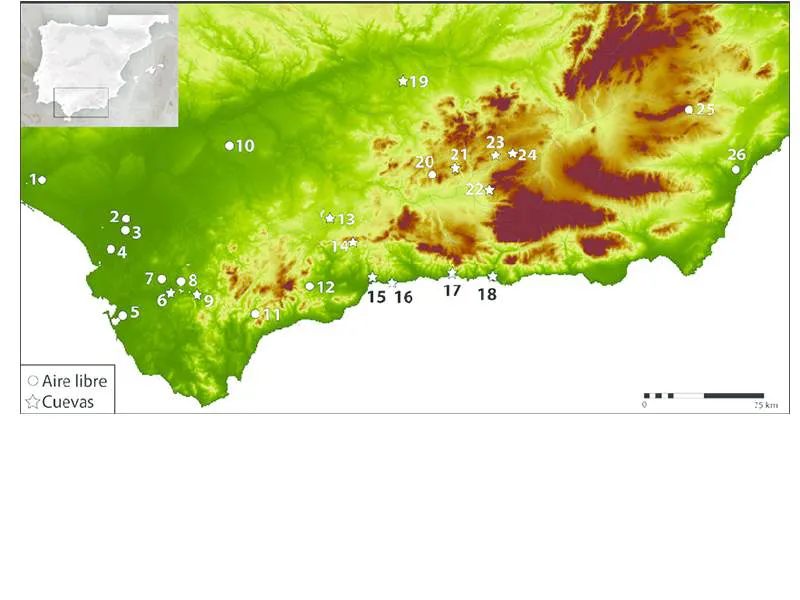
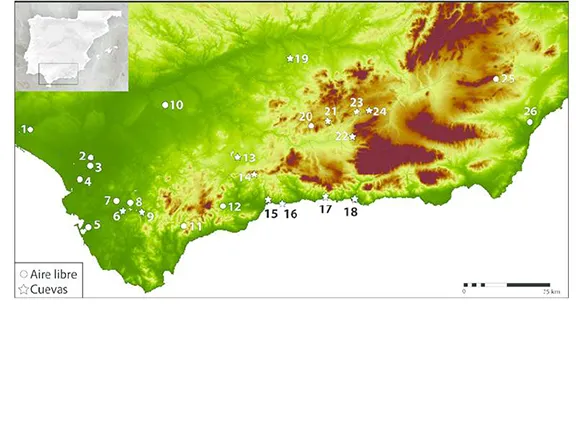
Cardial ware distribution
We can now turn our minds to the economy, how the land was managed. As already mentioned, the arrival of the Neolithic people coincided with a climate change that introduced increasing aridity to the area.
Western Andalucia presented a landscape covered by kermes oak and holm oak. Signs of anthropisation, managing the landscape, started during the second half of the 5th millennium, sometime after 4500 BC and intensified through to 3000 BC.Eastern Andalucia was covered in evergreen oak woodland except for Almeria that presented an arid environment. The lower flanks of the mountains had deciduous trees such as birch and oak, with maquis and pinewoods towards the coast. Here the first signs of anthropisation, including controlled burning of forest, start about 5500 BC. Burning the oak and pine forests allowed the low maquis to spread, creating pasture for livestock. The resulting type of maquis can still be seen along the coast of Malaga and in the Baetic ranges of Cordoba and Granada. The extremely well studied site of El Toro does not show any alteration of the landscape until about 4000 BC.
Inland in Granada province the dense forests of black pine in the Segura and Baza mountains show no evidence of any changes in vegetation or signs of deforestation, but there are signs of pastoral activity, possibly seasonal droving.
Archaeobotanical studies, looking at the interaction between humans and plants in the past, have been performed at Los Castillejos, El Toro, Los Murciélagos (Cordoba province) and Los Marmoles (Cordoba province). In addition, data from separate samples has been obtained from Nerja cave, Roca Chica and Hostal Guadalupe (Torremolinos, Malaga province) and La Higuera (Ardales, Malaga province).
The results show that, from the beginning, there was a predominance of cereals, dominated by naked wheat, apart from at Los Murciélagos where emmer wheat predominates. Legumes are also present including lentils, pea, broad bean, vetch (probably collected from the wild, the first signs of deliberate cultivation of vetch do not appear until Roman times), grass pea (grass pea contains a neurotoxin that can be removed by boiling) and bitter vetch (the typical bitterness is removed by soaking in water). The last three are all valuable fodder crops as well as reliable croppers in poor conditions, thereby providing insurance for their human carers. To these should be added flax, a valuable oilseed and opium poppy. Much has been made of the finding of poppy seeds at just two sites, Los Murciélagos (Granada) and Los Castillejos. In general their presence is considered an exception at that time in the Iberian Peninsula. This list represents practically the entire spectrum of domestic plant species of the central and western Mediterranean. The oldest specimens date from about 5500 BC and were found in the sites along the Malaga coast. Not too much should be read into this fact since the majority of early Neolithic sites have not yet been subject to systematic archaeobotanical studies.
The tools used to harvest the cereals consisted of curved handled sickles with sharp edged flints inserted. Abrasion stigmas in the form of striations and nicking in the honing of the blades indicated the cereals were cut at ground level. The straw would have been used for fodder or bedding.
Interestingly, the ancient species of naked wheat brought to the Iberian Peninsula by the Neolithic people is still grown in remote areas of Asturias in northern Spain; it is presumably better adapted to the wetter and generally colder climate experienced there. The same type of wheat is also grown to this day in some parts of Morocco where it is used solely for thatching their abodes.
In addition to the cultivated plants, wild food resources were still used. All the studied sites had olives and acorns (acorns are packed with healthy fats, vitamins, minerals, and plant compounds. They are particularly good sources of vitamins A and E).
The first evidence of agricultural practices is linked to intensive dryland cultivation (without irrigation) in limited spaces. Wheat and barley would have been sown together intentionally to minimise the risk of poor harvests and obtain a more qualitative use of cereal products, this was noticed particularly at El Toro. At Los Castillejos and Los Mármoles an occasional rotation or alternation between the different species of cereals has been suggested, lasting up to about 5300 BC. At Los Castillejos, El Toro, Los Murcielagos (Cordoba) and Marmoles, cereals appear processed and ready for consumption, which has led to the conclusion that the fields would be located close to the living space. This would facilitate their compatibility with other economic practices, such as livestock rearing.
Systematic studies of the animal remains found from this period have been made at Los Castillejos, La Molaina, El Retamar, El Toro, and Nerja. Single specimens found in earlier excavations have been considered from Cariguela, La Dehesilla, El Parralejo and Nerja.
The predominant species found are sheep and goat with lesser amounts of cattle and pig. At Los Castillejos and El Toro, an early preponderance of sheep over goat evened out over the first thousand years. The studies were able to identify how the livestock were managed at these two sites. Sheep and goats were slaughtered when they had reached full size, primary meat exploitation predominated. Baby lamb chops were definitely not on the menu. At Los Castillejos that practice also appertained to the management of cattle and pigs but at El Toro, cattle and pigs were slaughtered before the age of two.
Hunting remained important in the early Neolithic communities, the degree of importance differing between communities. At El Retamar, wildlife represents 95% of the total number of mammals found although this is an exceptional case. The most abundant wild animal found at all the sites is rabbit followed by red deer, horse, cattle and wild Iberian ibex. Researchers found that some sites had more of one wild species than others and that in some sites, hunting had less significance than in others. El Toro was overwhelmingly dominated by rabbit, probably caught in snares, because at this site and at Los Castillejos and Nerja caves there were few projectiles found. The latter two sites also had a low count of any wild animal remains.
On the other hand, as may be expected, the coastal sites, El Retamar and Nerja cave, show a greater preponderance for fish and shellfish than inland sites. At Los Castillejos and El Toro there are rare instances of mollusc shells. These have been related to personal adornment or as implements used in other craft work. At El Retamar and Nerja cave the range of species now reflects a warmer climate than the preceding Magdalenian period, snapper, pandora, grouper and just one member of the cod family, pollock. Snapper may have been as popular then as it is now, remains have been found at the inland site of Los Castillejos. Los Castillejos is an arduous 60 kilometres from the Mediterranean coast as the crow flies. Additionally, at El Retamar, gilthead seabream remains give a clue to the allotment of space within the domestic site. It is clear that there was an area for preparing fish and another for its consumption. From the species found at El Retamar, it appears as if the site was most often occupied in the autumn.
Domesticated animals all face the same genetic problems as humans, inbreeding is not desirable. This was as much a concern to Neolithic farmers as it is to farmers today. Recent years has seen more work on establishing the origin of domesticated farm animals and, for those in the Neolithic package, a pattern emerged.
Cattle, pigs, sheep and goats were all introduced into the Iberian Peninsula by Neolithic people. Their genetic origins were in the Middle East with a healthy dose of DNA from wild animals encountered en-route over the generations. Each move by a Neolithic party looking for new pastures included a few domesticated farm animals. On arrival at pastures new the domesticates were allowed to breed with the native animals.
Research into the origins of the Andalucian pig for instance, indicate that interbreeding with the wild boar was actively encouraged, the native wild boar was somewhat larger than the domesticate brought in.
Similarly research into the origins of domesticated cattle showed dilution of the original DNA as the cattle moved from the Middle East across Europe, bolstered by injections of DNA from the wild auroch.
Neither the wild boar nor the auroch are animals to be dealt with lightly. It is likely that the first breed of cattle to be truly domesticated, i.e. tractable enough to be trained to draw ploughs and carts, was one similar to today’s Chianna breed, the largest breed of cattle with its origins in Italy. Interestingly the Chianna only produces enough milk for suckling, it was bred for its qualities as a draught animal and for its meat. The Chianna breed emerged during the 1st millennium BC from the auroch/semi domesticated Middle East mix originally imported into Italy during the early Neolithic period.
The Andalucian equivalent is the Negra Andaluza, a medium sized breed, black as its name suggests, originally bred for its qualities as a draught animal and its meat. Until recent times (1960s) the Negra Andaluza could be found on rudimentary farms, basically living wild, in Seville, Cadiz and Cordoba provinces. Today the breed is endangered primarily due to crossbreeding.
In some respects, Andalucia has not changed much since early Neolithic times. Another ancient breed of cattle, again bred for its meat, is the Raza Retinta (Bos Taurus Turdetanus). As its name implies, its coat can be anything from red to chestnut in colour. Its image appears in some cave paintings, demonstrating its antiquity. Walkers in the Alcornocales Natural Park in Cadiz province are sometimes surprised to stumble across this cow, with its huge horns, staring out from the foliage. They are not to be trifled with, especially when accompanied by calves. Conversely the bull is an amiable beast who will amble away into the oak forest unless cornered.
The porcine equivalent of Raza Retinta is the Black Iberian Pig. Unlike the cattle, you are not likely to come across the domesticated pig in the wild. However, its cousin, the wild boar (Sus scrofa), still thrives in many areas of Andalucia and is still hunted. It is renowned for its ferocity.
It would not have been easy to persuade either cattle or pig to embark on a sea voyage, especially in a rudimentary canoe type vessel, possibly made from reeds. Although as mentioned in the previous article, cattle and pigs were transported by sea across to Cyprus some two thousand years before the events we are now looking at. Neither would it have been easy to herd them across the rough terrain and through oak forests due to their independent nature, even if helped by domesticated dogs, of which there are very few remains in the Iberian Peninsula.
Which leaves only two alternatives. Either the cow and the pig were introduced into existing Neolithic settlements at some time after the settlements were established, down the land based trading/exchange networks or the cattle and pig migrations from the Middle East were independent of the human migration although contemporaneous. If the latter, then this would not be the first time there has been such an occurrence.
Sheep and goats are a different matter. There is direct evidence that domesticated sheep and goats arrived in the Iberian Peninusula at the same time as the Neolithic people and so must have shared their mode of transport be it pedestrian or marine. Not only were the incoming animals allowed to breed with native species, they have also been bred with more incoming breeds throughout history. The Phoenicians, Romans and Arabs all introduced their own breeds. The famous Merino sheep is probably a result of sheep brought to the Iberian Peninsula by Greek traders during the 1st millennium BC breeding with sheep that had been domesticated for the previous four thousand years.
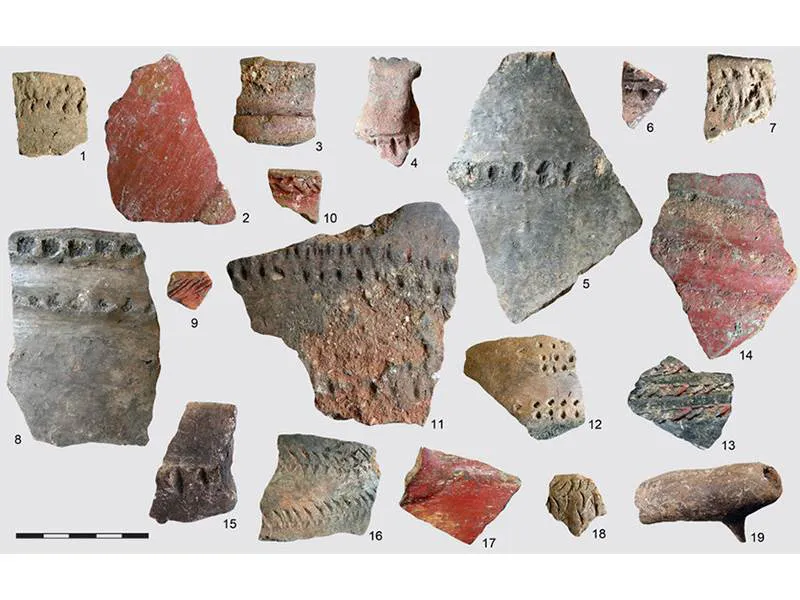
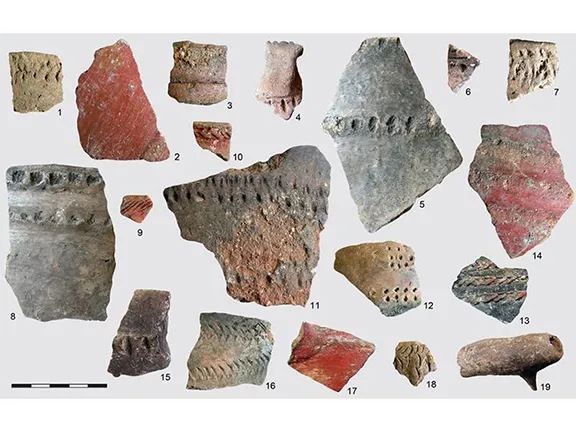
Ceramics from Nerja cave
In some cave sites, notably Nacimiento, an inland site near Pontones in Jaen province, La Dehesilla, an inland site in Cadiz province and Hoya de la Mina, a coastal site in Malaga province, and the Atlantic belt sites generally, the continued use of the Mesolithic type of tools is well documented. At all other sites a new technique appeared, the cutting of stone flakes and chips by pressure and heating of the cores. This technique also appears in sites in northern Morocco.
At some sites, Los Castillejos, Cabecicos Negros, La Molaina, El Toro, Los Murcielagos (Cordoba province), and Nerja cave, Mesolithic style geometric microliths are also present in small numbers. In all these cases the flint originated in locations separated from the domestic site.
Flint is not a common mineral. It is basically quartz that has been laid down as a sediment before it could fully crystallise. It is a variety of chert that occurs as nodules and sometimes larger masses, in limestone and chalk. In Andalucia there are a few places that flint occurs that were exploited during pre-historic times. Los Gallumbares in the western most part of Granada province, Cerro Alcolea, in Malaga province in the Axarquia region, Ardite/El Garrotal, near Tolox in the Sierra de las Nieves in Malaga province, Valle del Turón near Ardales in Malaga province, Malaver near Ronda, Malaga province, Calañas and Cerro de Andevalo in the foothills of the Sierra Morena in Huelva province.
Specialisation of activities at different sites starts to become apparent. At Cabecicos Negros raw flint was worked at the site whilst at Murcielagos (Cordoba province) and El Toro, the finished product was carried around and the only flint work that occurred at the sites was re-honing or conversion into other implements.
At El Toro, the finished implements were used to fillet meat prior to drying or smoking and work hides in such numbers that it has been inferred that the finished hides would then have been used in barter.
The settlement at Cabecicos Negros also processed hides but their specialisation was the manufacture of limestone and schist bracelets.
The Neolithic is of course known for the introduction of ceramics. In Andalucia, the defining characteristic of early ceramics is the huge diversity in form, manufacturing techniques and decoration. There is now no doubt that they followed different pottery traditions, emblematic of the identity of the different communities to produce containers for domestic, funerary and ritual purposes. There is a move to look for signs of the learning process as a means to characterise such patterns of diversity that mark distinctive ceramic styles to identify visible and tactile products of the transmission of knowledge and skills.
There have been many publications that attempted to categorise early pottery by shape, decoration or finish with a view to determining their origin, local or not, to establish general exchange networks and their range of mobility. Most were defeated by the sheer diversity of the ceramics and their occurrence over huge areas. The multifarious combinations of technique, shape and decoration made it an impossible task. Similar research much later, on the design, origin and final destination of amphorae had more success due to standardisation of design to facilitate packing. What did emerge from studies of Neolithic pottery was a broad categorisation of type.
Cardial ware, pottery decorated with the imprint of a cardium sea shell, is found throughout Andalucia concentrated in Malaga and Granada provinces. This is a particular form of the more general Impressed ware, pottery decorated with combs, fingernails, nicks and incised lines in geometric shapes, found all over the Iberian Peninsula throughout the early Neolithic period.
Notice that, on the map above, a few later Neolithic sites are shown in the valley of the Rio Guadalquivir.
Personal ornamentation was almost as diverse as pottery. Ornamentation was obviously an important part of Neolithic life, in personal wear and in rituals. It was also used as a medium of exchange, its value in the work that had gone into the piece, the rarity of the materials and the distance the finished object had travelled.
A workshop at Piedras Viñaeras in Cordoba province, specialised in the manufacture of limestone bracelets that then entered the exchange networks. Conversely, the bracelets manufactured at Los Mármoles were apparently destined for domestic use as burial goods.

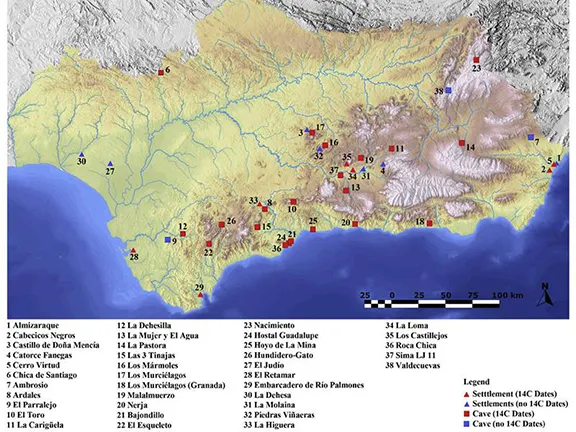
Early Neolithic sites Andalucia
Very little is known about the ritual life of the early Neolithic people of Andalucia. There seems to be no fixed pattern when it comes to burials. At La Dehesilla and El Toro, burials are associated with domestic living areas. Burials are also associated with some open-air sites such as Cerro Virtud and El Retamar.
In 2019 at El Toro, evidence was found to suggest that between 5000 and 4800 BC, seven individuals were buried within the cave. mtDNA testing showed that at least two of the individuals were first blood relatives, mother-daughter or sisters. More chillingly the research team found a skull carved into the shape of a cup or bowl and a jaw, together with containers deposited with the dead. The skull cup had been skinned and boiled to polish it. Other bones showed signs of chewing and of having been sucked of the nutrient rich marrow. In the same area, a few kilometres east, skull cups have been found at the Neolithic sites of Las Majólicas, Carigüela and Los Mármoles. Cannibalism was indicated in the first two by the presence of intentionally broken long bones and cut marks.
Less well dated is a burial site at Los Murciélagos cave (Albuñol, Granada). Excavated in the late 19th century, the burial cave was subsequently destroyed. The description of it was made at the time of its discovery. In the cave’s interior, the well-preserved mummified human remains of more than sixty people were found. Twelve of these individuals were located in a semicircle around a woman dressed in a leather tunic and adorned with a necklace of esparto grass, from which seashells and a carved boar tusk hung. Other skeletons were found in other chambers of the cave, often dressed in tunics, caps and esparto grass sandals with esparto grass baskets at their side. The remains are tentatively dated between 5000 and 4000 BC.
In Cerro Virtud (Almería), a 4.5 x 2.2 m burial pit was found, which had perhaps had a roof of perishable materials (the remains of a wooden beam were preserved). This contained the remains of 11 individuals laid out around a fireplace with one side bounded by three stones, one of which was a mill fragment. The 7 radiocarbon datings from the site place it between 5000 and 4500 BC.
Before we temporarily leave Andalucia, a summary of what happened in Andalucia may help to understand what occurred when the Neolithic arrived on the Atlantic shores.
From the evidence and research, it appears that about 5800 BC, Neolithic people started to infiltrate into Andalucia via the Mediterranean coast. They at first bypassed the arid region of Almeria, landing in Malaga province. They brought with them seeds and possibly sheep and goats and, at least, a thorough knowledge of animal husbandry. Initially they met Mesolithic people who still engaged in the traditional hunter-gatherer lifestyle consisting of seasonal migrations between settlement sites. Those Mesolithic people were willing partners, taking part in the Neolithic expansion by contributing their knowledge of the local topography, indigenous plants and animals, mineral resources and, crucially, tool making skills. The Neolithic people contributed their knowledge of animal husbandry, crop growing and pottery skills.
There is no evidence anywhere of there having been any conflict between the two, very different, cultural groups.
The transition between a Mesolithic existence and a fully Neolithic existence took at least 800 years. In the early years, the Neolithic people adopted a lifestyle almost indistinguishable from that of the Mesolithic. The Neolithic expanded by a combination of physical movement of people, possibly as part of a ‘coming of age’ rite and acculturation of pre-existing Mesolithic bands. As Neolithic semi-permanent settlements were established, many of them caves and shelters that had been used sporadically since Neanderthal times, the larger beasts, cattle and pigs, were brought in from areas that were already established.
At two locations, El Retamar and La Dehesa, Mesolithic people had managed to establish a more permanent presence by utilising all the resources available to them in a small area. They seemed content to continue with their own traditions, at least for the first few generations, and their territories were apparently avoided by the Neolithic people. That is not to say the Mesolithic people there were ostracised by the Neolithics, they became part of the wider trade/exchange networks.
Meanwhile the Neolithic people pressed on into Portugal until they arrived at the estuaries of the River Tagus and River Sado. They continued meeting Mesolithic bands who must, surely, have been expecting them, the news would have travelled down the networks. There two things happened. They met a Mesolithic group that had no initial interest in changing their comfortable way of life and, they finally ran out of land. The Neolithic had reached the Atlantic Ocean.
From roughly 5500 BC these Mesolithic hunter-gatherers coexisted with farmers who settled in the limestone massifs of the region between the Tagus and Mondego. Their huge shell middens gave substance and permanence to their settlements.
The Neolithic groups possessed domestic sheep (whose bones were dated by radiocarbon at the cave site of Caldeirão) and are defined by a material culture that is totally lacking in contemporary Mesolithic shell middens. It includes such items as cardial-decorated pottery, polished stone axes, and flint tools obtained with a technology involving heat pre-treatment of the rock. Among body ornaments, tear-shaped beads made from the Glycymeris (bittersweet clams) sea shell, as well as pierced red deer canines. Caves are used as cemeteries, and stable isotope analysis of these remains indicates a fully terrestrial diet, in marked contrast to that of the people buried in the Muge and Sado middens, indicating a very different way of life.
Occupation of these Portuguese estuary habitats seems to have peaked in about 6000 BC, before the Neolithic people arrived and lasted until 5000 – 4750 BC.
Amongst the Neolithic people, 5000 - 4700 BC was also a period of change. Many of the semi-permanent sites, such as El Toro, Los Murciélagos at Zuheros (Córdoba) and Los Castillejos were abandoned. After 4700 BC, many of the Neolithic people started to move into permanent settlements. A pattern emerged of large permanent settlements surrounded over a large area by homesteads in open areas such as the Guadalquivir valley and clusters of small, permanent settlements containing up to 30 homes in more confined areas such as the Gor valley in Granada province. The small settlements all had their own area of agricultural land.
But the most important factor in this part of our prehistory of Andalucia is the fact that the Neolithic people had reached the Atlantic Ocean. They could go no further west. The evidence strongly indicates that, rather than displace existing Mesolithic tribes ensconced on the western seaboard, the Neolithic people settled in very close proximity to them on the limestone escarpments behind the shell middens. There they co-habited for several generations. The Neolithic people, in order to increase their populations and the amount of land under cultivation had to reverse their line of advance and head east, back the way they had come, consolidating and expanding existing sites and creating new sites in previously unsettled areas.
Land became valuable and it became necessary to identify ownership. To do this it appears as if the Neolithic people borrowed a leaf from the Mesolithic book. The Mesolithic shell middens were already a powerful symbol of permanence, reinforced by also being the repository for ancestors. The Neolithic people built their own symbols and again altered the landscape. Today we recognise those symbols as dolmens, the first manifestation, in Andalucia, of megalithism.
Alday, Alfonso. (2012). The Neolithic in the Iberian Peninsula: An explanation from the perspective of the participation of Mesolithic communities. Zephyrus. 69. 75-94.
Berrocal, María. (2012). The Early Neolithic in the Iberian Peninsula and the Western Mediterranean: A Review of the Evidence on Migration. Journal of World Prehistory. 25. 10.1007/s10963-012-9059-9.
Borja, Pablo & Aura Tortosa, J. and Jordá Pardo, Jesús & Salazar-García, D.C.. (2014). Neolithic pottery from the cave of Nerja (Málaga, Spain): The 'Vestíbulo'and 'Mina' galleries. Archivo de Prehistoria Levantina. 30. 81-131.
Carrasco Rus, Javier & Martínez-Sevilla, Francisco. (2014). The absolute chronology of the early Neolithic in southern Iberia. New dates. Archivo de Prehistoria Levantina. 30. 57-80.
Hadjikoumis, Angelos. (2010). The origins and evolution of pig domestication in prehistoric Spain.
Isern, Neus & Fort, Joaquim & Carvalho, António & Gibaja, Juan & Ibáñez, Juan. (2014). The Neolithic Transition in the Iberian Peninsula: Data Analysis and Modeling. Journal of Archaeological Method and Theory. 21. 10.1007/s10816-013-9193-4.
Lacan, Marie & Keyser, Christine & Ricaut, Francois & Brucato, Nicolas & Duranthon, Francis & Guilaine, Jean & Crubezy, E. and Ludes, Bertrand. (2011). Ancient DNA reveals male diffusion through the Neolithic Mediterranean route. Proceedings of the National Academy of Sciences of the United States of America. 108. 9788-91. 10.1073/pnas.1100723108.
Martín Socas, Dimas & CÁMALICH, M. & Buxó, Ramon & CHÁVEZ, M. & ECHALLIER, J. & Gonzalez Quintero, Pedro & GOÑI, A. & MAÑOSA, M. & Orozco, Teresita & PAZ, M.A. & Rodríguez Ariza, María Oliva & RODRÍGUEZ, A. & Tusell, M. & WATSON, J.P.N.. (2004). Cueva de El Toro (Antequera, Málaga-Spain). A Neolithic Stockbreeding Community in the Andalusian region between VI-III millenniums B.C.. Documenta Praehistorica. XXX. 126-143.
Martín Socas, Dimas & Massieu, María & Caro, José & Rodríguez-Santos, F.. (2017). The beginning of the Neolithic in Andalusia. Quaternary International. 10.1016/j.quaint.2017.06.057.
Martínez-Sevilla, Francisco. (2011). Algunas cuestiones sobre los asentamientos al aire libre del Neolítico Antiguo/Medio en “La Vega” de Granada.
Martínez-Sevilla, Francisco & Morgado, Antonio & Cobos, Fancisca & Gutiérrez-Rodríguez, Mario & Lopez Garcia, Antonio & Lozano Rodríguez, José & Carrasco Rus, Javier. (2016). Knapping methods and techniques in the bracelets quarry of Cortijo Cevico (Loja, Granada). Journal of Lithic Studies. 3. 10.2218/jls.v3i2.1450.
Martínez-Sevilla, Francisco. (2019). Assessing the cultural and social value of Neolithic stone bracelets in the Iberian Peninsula. Journal of Anthropological Archaeology. 10.1016/j.jaa.2019.101080.
Massieu, María & Martín Socas, Dimas & Gonzalez Quintero, Pedro & Quinteiro, Amaya & Rodríguez, Amelia. (2004). The Neolithic in Almería: The valley of the Almanzora river and Vera basin. Documenta Praehistorica. XXXI. 183 - 197. 10.4312/dp.31.13.
Morgado, Antonio & Lozano Rodríguez, José & Pelegrin, Jacques. (2011). Las explotaciones prehistóricas del sílex de la Formación Milanos (Granada, España). Menga: Journal of Andalusian Prehistory. 2. 135-155.
Morgado, Antonio & Pelegrin, Jacques. (2013). Origin and development of pressure blade production in the Southern Iberian Peninsula (6th-3rd Millennia B.C.). The Emergence of Pressure Blade Making: From Origin to Modern Experimentation. 219-235. 10.1007/978-1-4614-2003-3-8.
Peña-Chocarro, Leonor & Zapata, Lydia. (2010). Neolithic agriculture in southwestern Mediterranean region. 15.
Pereira, Filipe & Davis, Simon & Pereira, Luisa & McEvoy, Brian & Bradley, Daniel & Amorim, António. (2006). Genetic Signatures of a Mediterranean Influence in Iberian Peninsula Sheep Husbandry. Molecular biology and evolution. 23. 1420-6. 10.1093/molbev/msl007.
Santana, Jonathan & Rodríguez Santos, Francisco Javier & Massieu, María & Martín Socas, Dimas & Fregel, Rosa. (2019). Aggressive or funerary cannibalism? Skull-cup and human bone manipulation in Cueva de El Toro (Early Neolithic, southern Iberia). American Journal of Physical Anthropology. 10.1002/ajpa.23805.
Scheu, Amelie & Powell, Adam & Bollongino, Ruth & Vigne, Jean-Denis & Tresset, Anne & Cakirlar, Canan & Benecke, Norbert & Burger, Joachim. (2015). The genetic prehistory of domesticated cattle from their origin to the spread across Europe. BMC Genetics. 16. 10.1186/s12863-015-0203-2.
Zapata, Lydia & Peña-Chocarro, Leonor & Perez, Guillem & Stika, Hans-Peter. (2004). Early Neolithic Agriculture in the Iberian Peninsula. Journal of World Prehistory. 18. 283-325. 10.1007/s10963-004-5621-4.
To read the full pdf with all images and maps click here